TAFE NSW: CHCDIV001/CHCDIV002 Project on Diversity and Inclusion
VerifiedAdded on 2023/06/18
|18
|7375
|82
Report
AI Summary
This document presents a solution to a project encompassing CHCDIV001 (Work with diverse people) and CHCDIV002 (Promote Aboriginal and/or Torres Strait Islander cultural safety). Task 1 addresses understanding and strategies for marginalized cultural groups, focusing on overcoming communication barriers and daily obstacles. It emphasizes the importance of respectful and clear communication, cultural awareness, and avoiding judgment. Task 2 delves into working effectively with Aboriginal and Torres Strait Islander peoples, highlighting the need to respect their diverse cultures, family structures, and beliefs. It explores legal protections against discrimination, including relevant legislations, and stresses the significance of cultural competence in community service roles. The solution also examines the impact of cultural diversity in the workplace, addressing potential barriers and needs, and provides an in-depth analysis of religious or spiritual beliefs within Indigenous communities, underlining the importance of understanding their history and customs. The document is designed to demonstrate competency in these units and satisfy assessment criteria through well-researched and referenced responses.
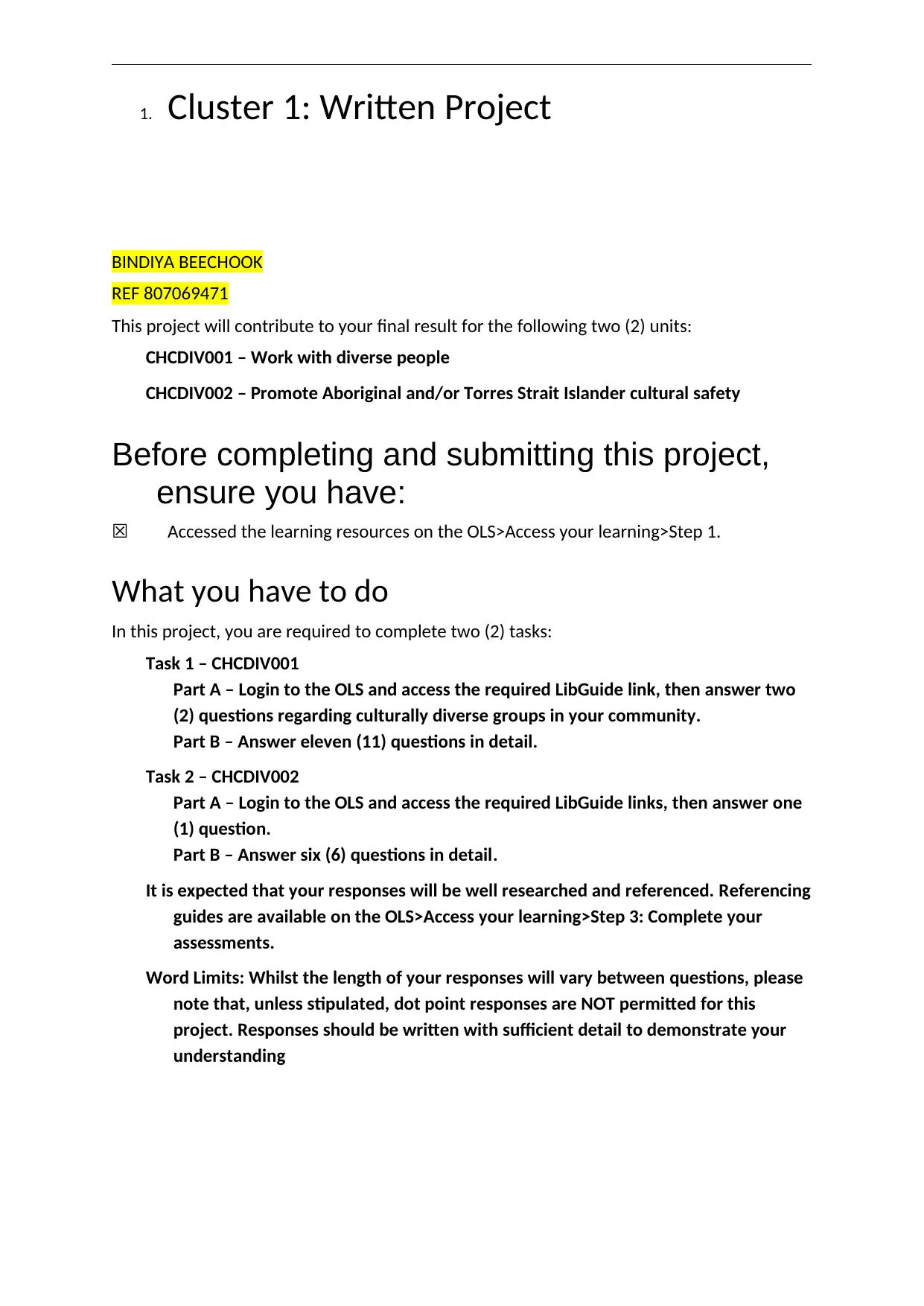
1. Cluster 1: Written Project
BINDIYA BEECHOOK
REF 807069471
This project will contribute to your final result for the following two (2) units:
CHCDIV001 – Work with diverse people
CHCDIV002 – Promote Aboriginal and/or Torres Strait Islander cultural safety
Before completing and submitting this project,
ensure you have:
☒ Accessed the learning resources on the OLS>Access your learning>Step 1.
What you have to do
In this project, you are required to complete two (2) tasks:
Task 1 – CHCDIV001
Part A – Login to the OLS and access the required LibGuide link, then answer two
(2) questions regarding culturally diverse groups in your community.
Part B – Answer eleven (11) questions in detail.
Task 2 – CHCDIV002
Part A – Login to the OLS and access the required LibGuide links, then answer one
(1) question.
Part B – Answer six (6) questions in detail.
It is expected that your responses will be well researched and referenced. Referencing
guides are available on the OLS>Access your learning>Step 3: Complete your
assessments.
Word Limits: Whilst the length of your responses will vary between questions, please
note that, unless stipulated, dot point responses are NOT permitted for this
project. Responses should be written with sufficient detail to demonstrate your
understanding
BINDIYA BEECHOOK
REF 807069471
This project will contribute to your final result for the following two (2) units:
CHCDIV001 – Work with diverse people
CHCDIV002 – Promote Aboriginal and/or Torres Strait Islander cultural safety
Before completing and submitting this project,
ensure you have:
☒ Accessed the learning resources on the OLS>Access your learning>Step 1.
What you have to do
In this project, you are required to complete two (2) tasks:
Task 1 – CHCDIV001
Part A – Login to the OLS and access the required LibGuide link, then answer two
(2) questions regarding culturally diverse groups in your community.
Part B – Answer eleven (11) questions in detail.
Task 2 – CHCDIV002
Part A – Login to the OLS and access the required LibGuide links, then answer one
(1) question.
Part B – Answer six (6) questions in detail.
It is expected that your responses will be well researched and referenced. Referencing
guides are available on the OLS>Access your learning>Step 3: Complete your
assessments.
Word Limits: Whilst the length of your responses will vary between questions, please
note that, unless stipulated, dot point responses are NOT permitted for this
project. Responses should be written with sufficient detail to demonstrate your
understanding
Paraphrase This Document
Need a fresh take? Get an instant paraphrase of this document with our AI Paraphraser
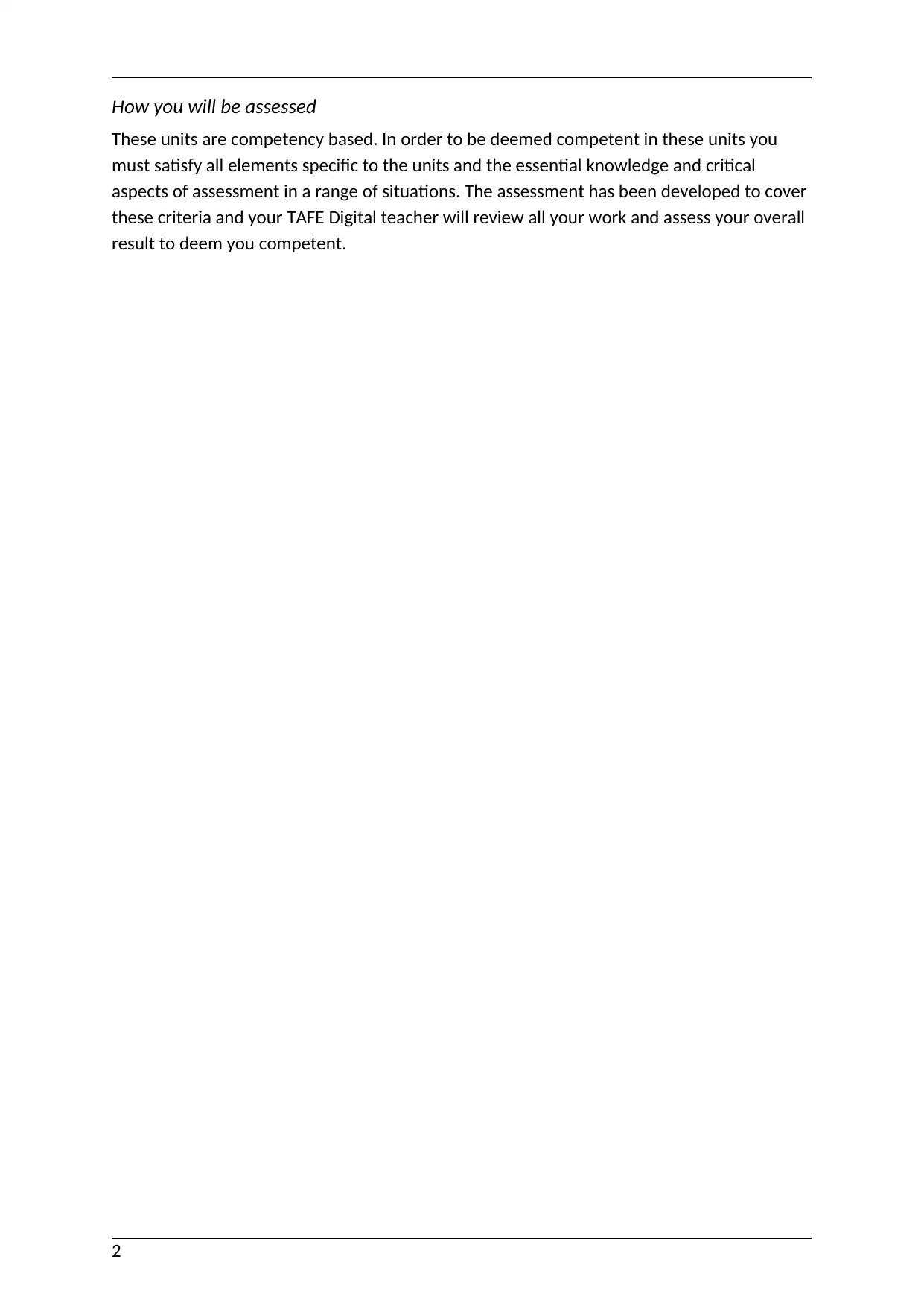
How you will be assessed
These units are competency based. In order to be deemed competent in these units you
must satisfy all elements specific to the units and the essential knowledge and critical
aspects of assessment in a range of situations. The assessment has been developed to cover
these criteria and your TAFE Digital teacher will review all your work and assess your overall
result to deem you competent.
2
These units are competency based. In order to be deemed competent in these units you
must satisfy all elements specific to the units and the essential knowledge and critical
aspects of assessment in a range of situations. The assessment has been developed to cover
these criteria and your TAFE Digital teacher will review all your work and assess your overall
result to deem you competent.
2
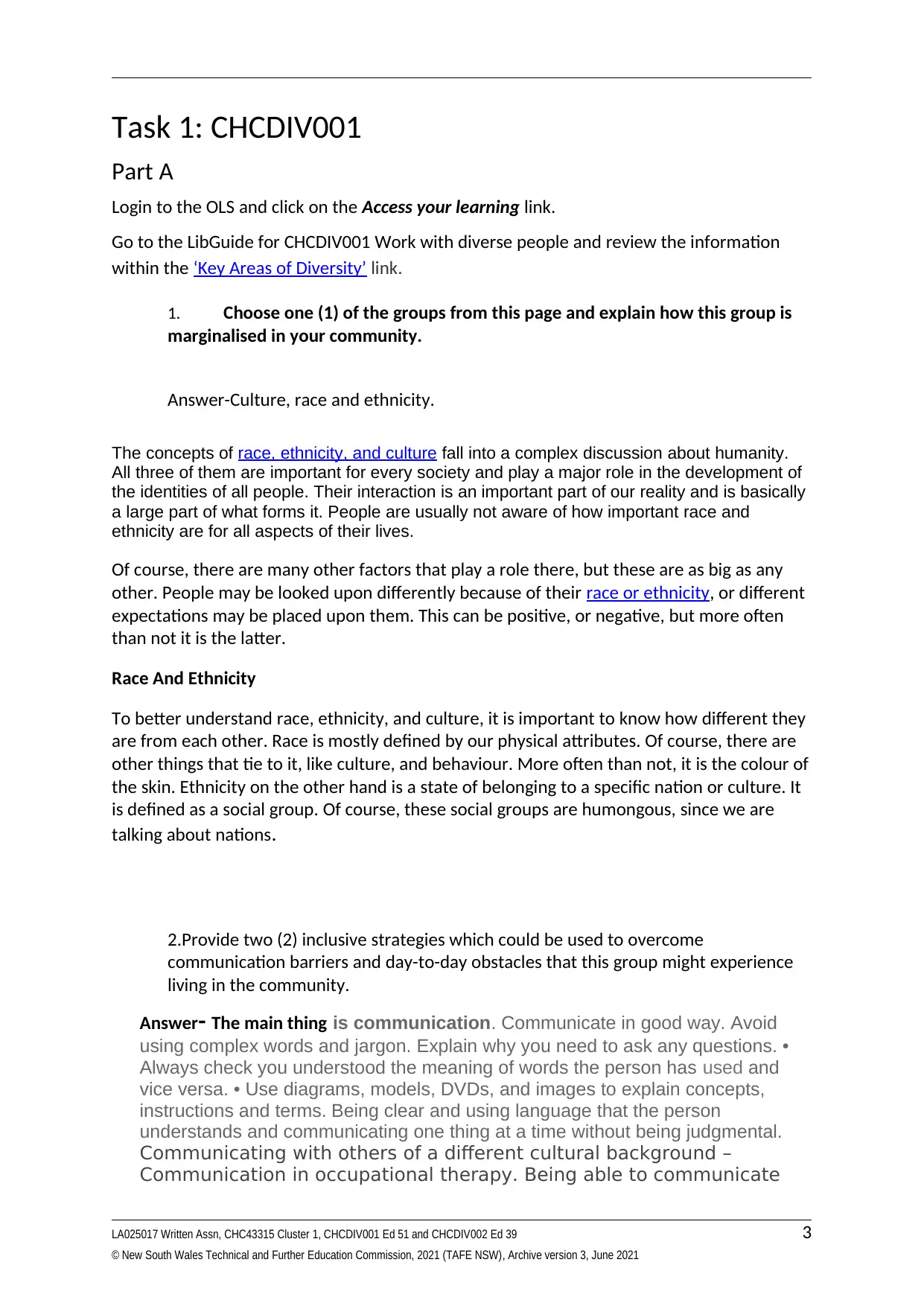
Task 1: CHCDIV001
Part A
Login to the OLS and click on the Access your learning link.
Go to the LibGuide for CHCDIV001 Work with diverse people and review the information
within the ‘Key Areas of Diversity’ link.
1. Choose one (1) of the groups from this page and explain how this group is
marginalised in your community.
Answer-Culture, race and ethnicity.
The concepts of race, ethnicity, and culture fall into a complex discussion about humanity.
All three of them are important for every society and play a major role in the development of
the identities of all people. Their interaction is an important part of our reality and is basically
a large part of what forms it. People are usually not aware of how important race and
ethnicity are for all aspects of their lives.
Of course, there are many other factors that play a role there, but these are as big as any
other. People may be looked upon differently because of their race or ethnicity, or different
expectations may be placed upon them. This can be positive, or negative, but more often
than not it is the latter.
Race And Ethnicity
To better understand race, ethnicity, and culture, it is important to know how different they
are from each other. Race is mostly defined by our physical attributes. Of course, there are
other things that tie to it, like culture, and behaviour. More often than not, it is the colour of
the skin. Ethnicity on the other hand is a state of belonging to a specific nation or culture. It
is defined as a social group. Of course, these social groups are humongous, since we are
talking about nations.
2.Provide two (2) inclusive strategies which could be used to overcome
communication barriers and day-to-day obstacles that this group might experience
living in the community.
Answer- The main thing is communication. Communicate in good way. Avoid
using complex words and jargon. Explain why you need to ask any questions. •
Always check you understood the meaning of words the person has used and
vice versa. • Use diagrams, models, DVDs, and images to explain concepts,
instructions and terms. Being clear and using language that the person
understands and communicating one thing at a time without being judgmental.
Communicating with others of a different cultural background –
Communication in occupational therapy. Being able to communicate
LA025017 Written Assn, CHC43315 Cluster 1, CHCDIV001 Ed 51 and CHCDIV002 Ed 39 3
© New South Wales Technical and Further Education Commission, 2021 (TAFE NSW), Archive version 3, June 2021
Part A
Login to the OLS and click on the Access your learning link.
Go to the LibGuide for CHCDIV001 Work with diverse people and review the information
within the ‘Key Areas of Diversity’ link.
1. Choose one (1) of the groups from this page and explain how this group is
marginalised in your community.
Answer-Culture, race and ethnicity.
The concepts of race, ethnicity, and culture fall into a complex discussion about humanity.
All three of them are important for every society and play a major role in the development of
the identities of all people. Their interaction is an important part of our reality and is basically
a large part of what forms it. People are usually not aware of how important race and
ethnicity are for all aspects of their lives.
Of course, there are many other factors that play a role there, but these are as big as any
other. People may be looked upon differently because of their race or ethnicity, or different
expectations may be placed upon them. This can be positive, or negative, but more often
than not it is the latter.
Race And Ethnicity
To better understand race, ethnicity, and culture, it is important to know how different they
are from each other. Race is mostly defined by our physical attributes. Of course, there are
other things that tie to it, like culture, and behaviour. More often than not, it is the colour of
the skin. Ethnicity on the other hand is a state of belonging to a specific nation or culture. It
is defined as a social group. Of course, these social groups are humongous, since we are
talking about nations.
2.Provide two (2) inclusive strategies which could be used to overcome
communication barriers and day-to-day obstacles that this group might experience
living in the community.
Answer- The main thing is communication. Communicate in good way. Avoid
using complex words and jargon. Explain why you need to ask any questions. •
Always check you understood the meaning of words the person has used and
vice versa. • Use diagrams, models, DVDs, and images to explain concepts,
instructions and terms. Being clear and using language that the person
understands and communicating one thing at a time without being judgmental.
Communicating with others of a different cultural background –
Communication in occupational therapy. Being able to communicate
LA025017 Written Assn, CHC43315 Cluster 1, CHCDIV001 Ed 51 and CHCDIV002 Ed 39 3
© New South Wales Technical and Further Education Commission, 2021 (TAFE NSW), Archive version 3, June 2021
⊘ This is a preview!⊘
Do you want full access?
Subscribe today to unlock all pages.

Trusted by 1+ million students worldwide
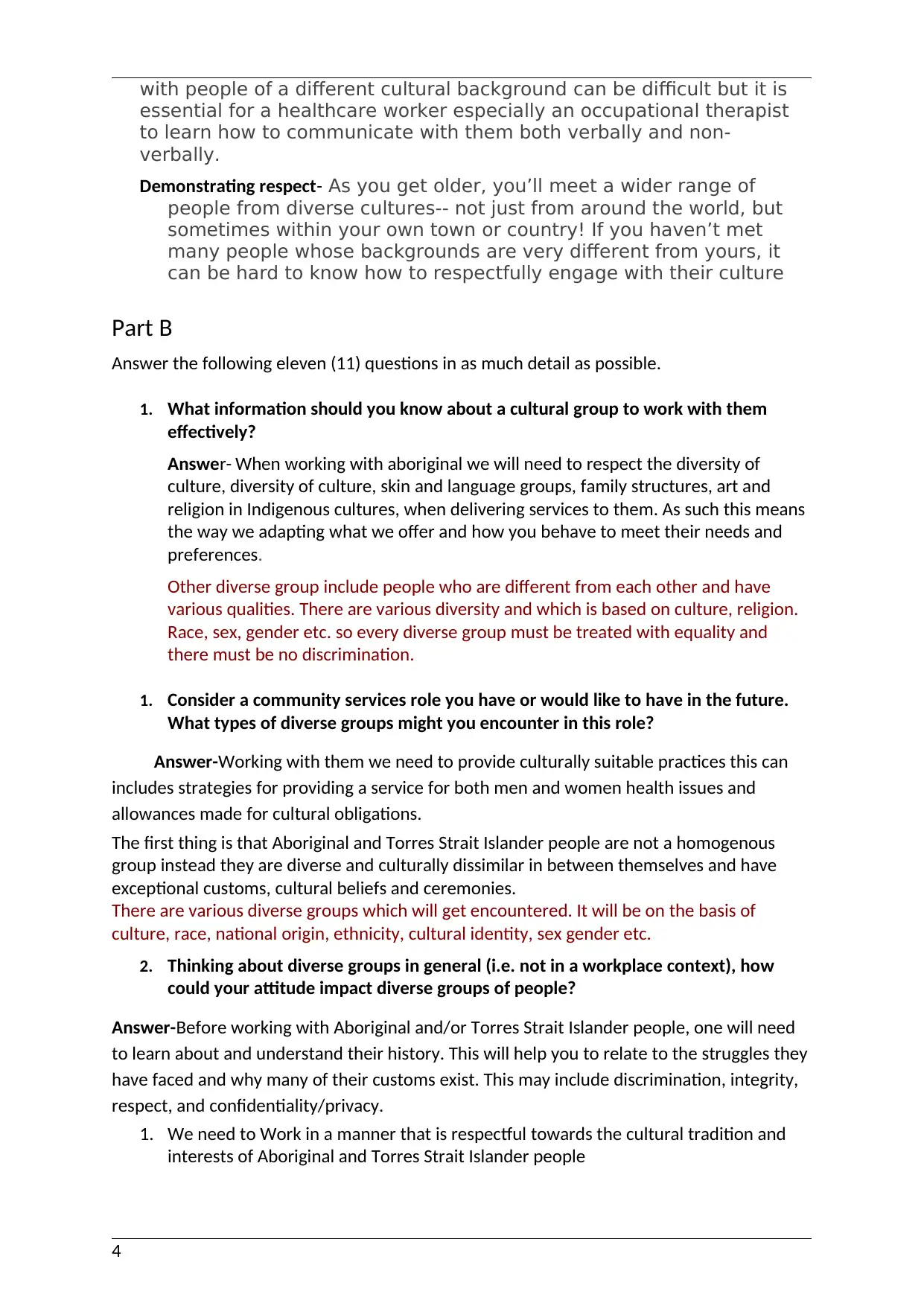
with people of a different cultural background can be difficult but it is
essential for a healthcare worker especially an occupational therapist
to learn how to communicate with them both verbally and non-
verbally.
Demonstrating respect- As you get older, you’ll meet a wider range of
people from diverse cultures-- not just from around the world, but
sometimes within your own town or country! If you haven’t met
many people whose backgrounds are very different from yours, it
can be hard to know how to respectfully engage with their culture
Part B
Answer the following eleven (11) questions in as much detail as possible.
1. What information should you know about a cultural group to work with them
effectively?
Answer- When working with aboriginal we will need to respect the diversity of
culture, diversity of culture, skin and language groups, family structures, art and
religion in Indigenous cultures, when delivering services to them. As such this means
the way we adapting what we offer and how you behave to meet their needs and
preferences.
Other diverse group include people who are different from each other and have
various qualities. There are various diversity and which is based on culture, religion.
Race, sex, gender etc. so every diverse group must be treated with equality and
there must be no discrimination.
1. Consider a community services role you have or would like to have in the future.
What types of diverse groups might you encounter in this role?
Answer-Working with them we need to provide culturally suitable practices this can
includes strategies for providing a service for both men and women health issues and
allowances made for cultural obligations.
The first thing is that Aboriginal and Torres Strait Islander people are not a homogenous
group instead they are diverse and culturally dissimilar in between themselves and have
exceptional customs, cultural beliefs and ceremonies.
There are various diverse groups which will get encountered. It will be on the basis of
culture, race, national origin, ethnicity, cultural identity, sex gender etc.
2. Thinking about diverse groups in general (i.e. not in a workplace context), how
could your attitude impact diverse groups of people?
Answer-Before working with Aboriginal and/or Torres Strait Islander people, one will need
to learn about and understand their history. This will help you to relate to the struggles they
have faced and why many of their customs exist. This may include discrimination, integrity,
respect, and confidentiality/privacy.
1. We need to Work in a manner that is respectful towards the cultural tradition and
interests of Aboriginal and Torres Strait Islander people
4
essential for a healthcare worker especially an occupational therapist
to learn how to communicate with them both verbally and non-
verbally.
Demonstrating respect- As you get older, you’ll meet a wider range of
people from diverse cultures-- not just from around the world, but
sometimes within your own town or country! If you haven’t met
many people whose backgrounds are very different from yours, it
can be hard to know how to respectfully engage with their culture
Part B
Answer the following eleven (11) questions in as much detail as possible.
1. What information should you know about a cultural group to work with them
effectively?
Answer- When working with aboriginal we will need to respect the diversity of
culture, diversity of culture, skin and language groups, family structures, art and
religion in Indigenous cultures, when delivering services to them. As such this means
the way we adapting what we offer and how you behave to meet their needs and
preferences.
Other diverse group include people who are different from each other and have
various qualities. There are various diversity and which is based on culture, religion.
Race, sex, gender etc. so every diverse group must be treated with equality and
there must be no discrimination.
1. Consider a community services role you have or would like to have in the future.
What types of diverse groups might you encounter in this role?
Answer-Working with them we need to provide culturally suitable practices this can
includes strategies for providing a service for both men and women health issues and
allowances made for cultural obligations.
The first thing is that Aboriginal and Torres Strait Islander people are not a homogenous
group instead they are diverse and culturally dissimilar in between themselves and have
exceptional customs, cultural beliefs and ceremonies.
There are various diverse groups which will get encountered. It will be on the basis of
culture, race, national origin, ethnicity, cultural identity, sex gender etc.
2. Thinking about diverse groups in general (i.e. not in a workplace context), how
could your attitude impact diverse groups of people?
Answer-Before working with Aboriginal and/or Torres Strait Islander people, one will need
to learn about and understand their history. This will help you to relate to the struggles they
have faced and why many of their customs exist. This may include discrimination, integrity,
respect, and confidentiality/privacy.
1. We need to Work in a manner that is respectful towards the cultural tradition and
interests of Aboriginal and Torres Strait Islander people
4
Paraphrase This Document
Need a fresh take? Get an instant paraphrase of this document with our AI Paraphraser
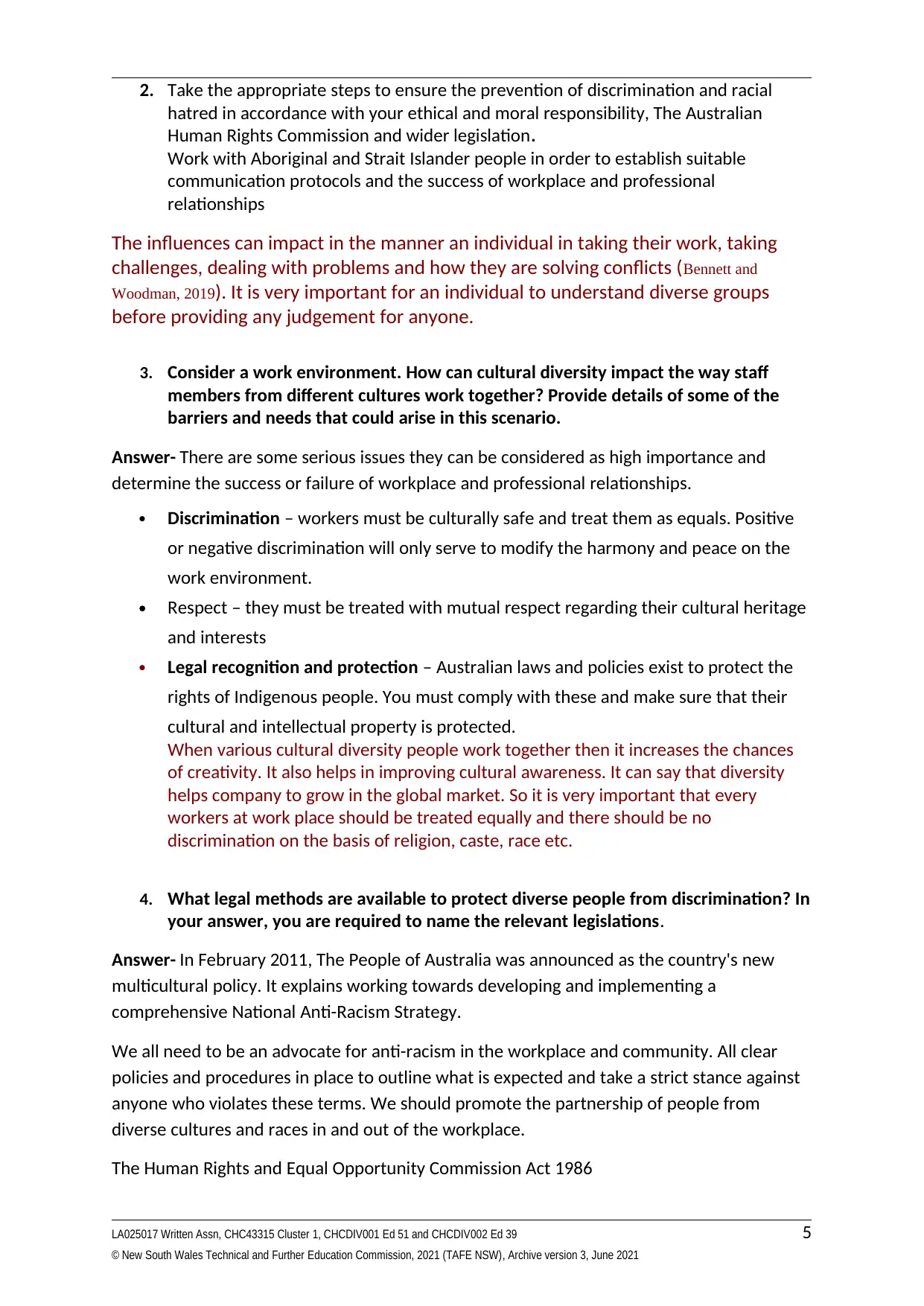
2. Take the appropriate steps to ensure the prevention of discrimination and racial
hatred in accordance with your ethical and moral responsibility, The Australian
Human Rights Commission and wider legislation.
Work with Aboriginal and Strait Islander people in order to establish suitable
communication protocols and the success of workplace and professional
relationships
The influences can impact in the manner an individual in taking their work, taking
challenges, dealing with problems and how they are solving conflicts (Bennett and
Woodman, 2019). It is very important for an individual to understand diverse groups
before providing any judgement for anyone.
3. Consider a work environment. How can cultural diversity impact the way staff
members from different cultures work together? Provide details of some of the
barriers and needs that could arise in this scenario.
Answer- There are some serious issues they can be considered as high importance and
determine the success or failure of workplace and professional relationships.
Discrimination – workers must be culturally safe and treat them as equals. Positive
or negative discrimination will only serve to modify the harmony and peace on the
work environment.
Respect – they must be treated with mutual respect regarding their cultural heritage
and interests
Legal recognition and protection – Australian laws and policies exist to protect the
rights of Indigenous people. You must comply with these and make sure that their
cultural and intellectual property is protected.
When various cultural diversity people work together then it increases the chances
of creativity. It also helps in improving cultural awareness. It can say that diversity
helps company to grow in the global market. So it is very important that every
workers at work place should be treated equally and there should be no
discrimination on the basis of religion, caste, race etc.
4. What legal methods are available to protect diverse people from discrimination? In
your answer, you are required to name the relevant legislations.
Answer- In February 2011, The People of Australia was announced as the country's new
multicultural policy. It explains working towards developing and implementing a
comprehensive National Anti-Racism Strategy.
We all need to be an advocate for anti-racism in the workplace and community. All clear
policies and procedures in place to outline what is expected and take a strict stance against
anyone who violates these terms. We should promote the partnership of people from
diverse cultures and races in and out of the workplace.
The Human Rights and Equal Opportunity Commission Act 1986
LA025017 Written Assn, CHC43315 Cluster 1, CHCDIV001 Ed 51 and CHCDIV002 Ed 39 5
© New South Wales Technical and Further Education Commission, 2021 (TAFE NSW), Archive version 3, June 2021
hatred in accordance with your ethical and moral responsibility, The Australian
Human Rights Commission and wider legislation.
Work with Aboriginal and Strait Islander people in order to establish suitable
communication protocols and the success of workplace and professional
relationships
The influences can impact in the manner an individual in taking their work, taking
challenges, dealing with problems and how they are solving conflicts (Bennett and
Woodman, 2019). It is very important for an individual to understand diverse groups
before providing any judgement for anyone.
3. Consider a work environment. How can cultural diversity impact the way staff
members from different cultures work together? Provide details of some of the
barriers and needs that could arise in this scenario.
Answer- There are some serious issues they can be considered as high importance and
determine the success or failure of workplace and professional relationships.
Discrimination – workers must be culturally safe and treat them as equals. Positive
or negative discrimination will only serve to modify the harmony and peace on the
work environment.
Respect – they must be treated with mutual respect regarding their cultural heritage
and interests
Legal recognition and protection – Australian laws and policies exist to protect the
rights of Indigenous people. You must comply with these and make sure that their
cultural and intellectual property is protected.
When various cultural diversity people work together then it increases the chances
of creativity. It also helps in improving cultural awareness. It can say that diversity
helps company to grow in the global market. So it is very important that every
workers at work place should be treated equally and there should be no
discrimination on the basis of religion, caste, race etc.
4. What legal methods are available to protect diverse people from discrimination? In
your answer, you are required to name the relevant legislations.
Answer- In February 2011, The People of Australia was announced as the country's new
multicultural policy. It explains working towards developing and implementing a
comprehensive National Anti-Racism Strategy.
We all need to be an advocate for anti-racism in the workplace and community. All clear
policies and procedures in place to outline what is expected and take a strict stance against
anyone who violates these terms. We should promote the partnership of people from
diverse cultures and races in and out of the workplace.
The Human Rights and Equal Opportunity Commission Act 1986
LA025017 Written Assn, CHC43315 Cluster 1, CHCDIV001 Ed 51 and CHCDIV002 Ed 39 5
© New South Wales Technical and Further Education Commission, 2021 (TAFE NSW), Archive version 3, June 2021
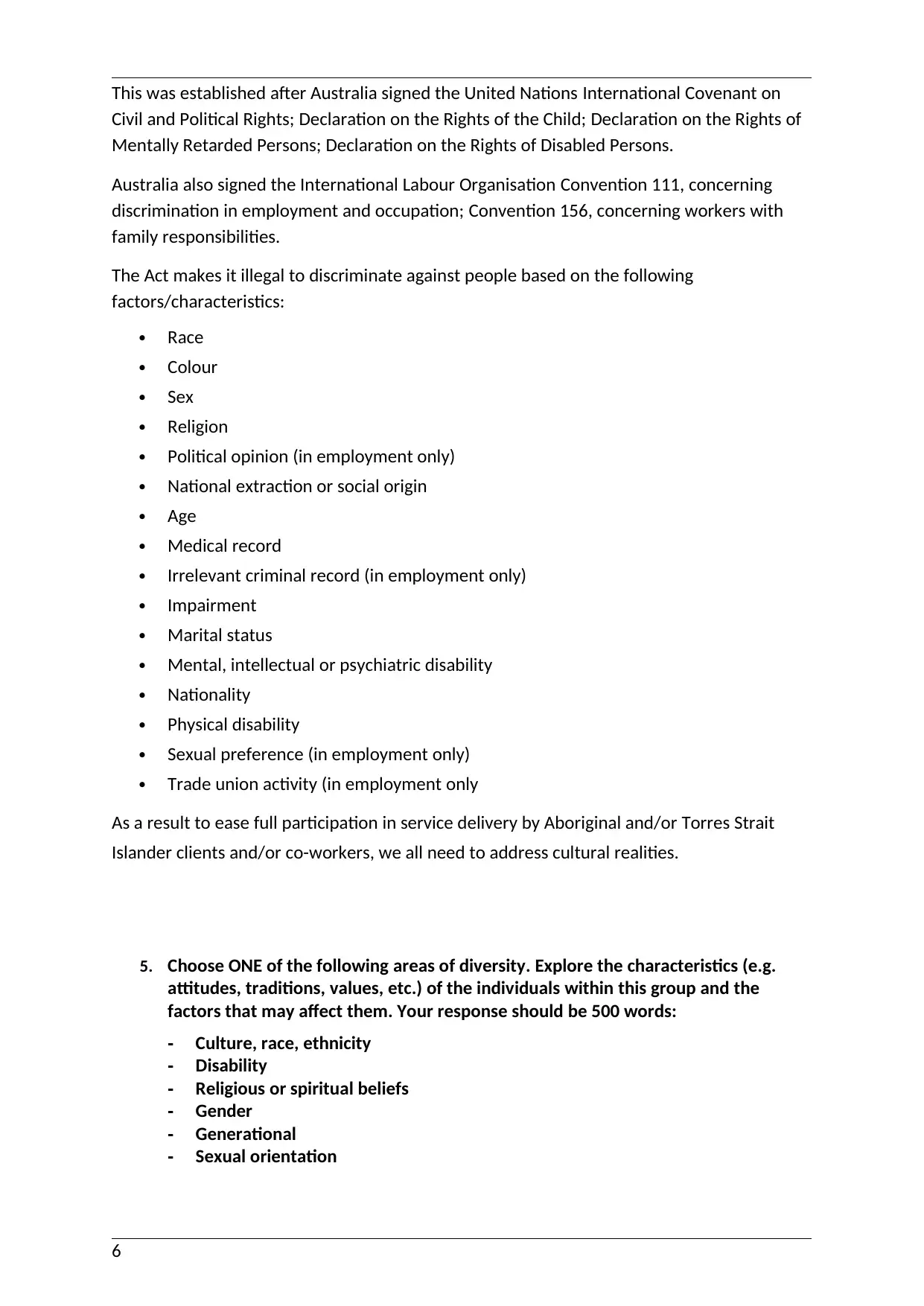
This was established after Australia signed the United Nations International Covenant on
Civil and Political Rights; Declaration on the Rights of the Child; Declaration on the Rights of
Mentally Retarded Persons; Declaration on the Rights of Disabled Persons.
Australia also signed the International Labour Organisation Convention 111, concerning
discrimination in employment and occupation; Convention 156, concerning workers with
family responsibilities.
The Act makes it illegal to discriminate against people based on the following
factors/characteristics:
Race
Colour
Sex
Religion
Political opinion (in employment only)
National extraction or social origin
Age
Medical record
Irrelevant criminal record (in employment only)
Impairment
Marital status
Mental, intellectual or psychiatric disability
Nationality
Physical disability
Sexual preference (in employment only)
Trade union activity (in employment only
As a result to ease full participation in service delivery by Aboriginal and/or Torres Strait
Islander clients and/or co-workers, we all need to address cultural realities.
5. Choose ONE of the following areas of diversity. Explore the characteristics (e.g.
attitudes, traditions, values, etc.) of the individuals within this group and the
factors that may affect them. Your response should be 500 words:
- Culture, race, ethnicity
- Disability
- Religious or spiritual beliefs
- Gender
- Generational
- Sexual orientation
6
Civil and Political Rights; Declaration on the Rights of the Child; Declaration on the Rights of
Mentally Retarded Persons; Declaration on the Rights of Disabled Persons.
Australia also signed the International Labour Organisation Convention 111, concerning
discrimination in employment and occupation; Convention 156, concerning workers with
family responsibilities.
The Act makes it illegal to discriminate against people based on the following
factors/characteristics:
Race
Colour
Sex
Religion
Political opinion (in employment only)
National extraction or social origin
Age
Medical record
Irrelevant criminal record (in employment only)
Impairment
Marital status
Mental, intellectual or psychiatric disability
Nationality
Physical disability
Sexual preference (in employment only)
Trade union activity (in employment only
As a result to ease full participation in service delivery by Aboriginal and/or Torres Strait
Islander clients and/or co-workers, we all need to address cultural realities.
5. Choose ONE of the following areas of diversity. Explore the characteristics (e.g.
attitudes, traditions, values, etc.) of the individuals within this group and the
factors that may affect them. Your response should be 500 words:
- Culture, race, ethnicity
- Disability
- Religious or spiritual beliefs
- Gender
- Generational
- Sexual orientation
6
⊘ This is a preview!⊘
Do you want full access?
Subscribe today to unlock all pages.

Trusted by 1+ million students worldwide
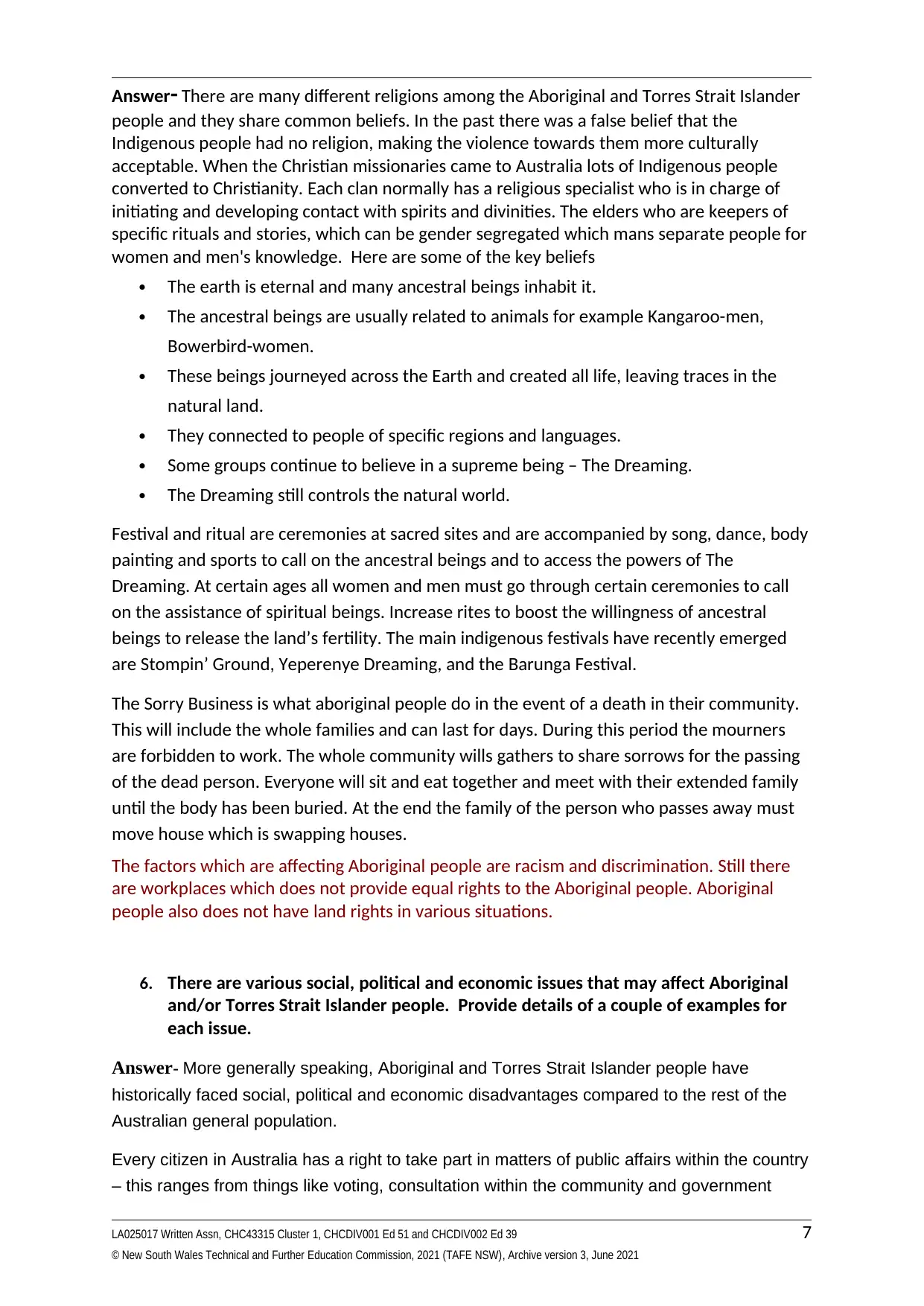
Answer- There are many different religions among the Aboriginal and Torres Strait Islander
people and they share common beliefs. In the past there was a false belief that the
Indigenous people had no religion, making the violence towards them more culturally
acceptable. When the Christian missionaries came to Australia lots of Indigenous people
converted to Christianity. Each clan normally has a religious specialist who is in charge of
initiating and developing contact with spirits and divinities. The elders who are keepers of
specific rituals and stories, which can be gender segregated which mans separate people for
women and men's knowledge. Here are some of the key beliefs
The earth is eternal and many ancestral beings inhabit it.
The ancestral beings are usually related to animals for example Kangaroo-men,
Bowerbird-women.
These beings journeyed across the Earth and created all life, leaving traces in the
natural land.
They connected to people of specific regions and languages.
Some groups continue to believe in a supreme being – The Dreaming.
The Dreaming still controls the natural world.
Festival and ritual are ceremonies at sacred sites and are accompanied by song, dance, body
painting and sports to call on the ancestral beings and to access the powers of The
Dreaming. At certain ages all women and men must go through certain ceremonies to call
on the assistance of spiritual beings. Increase rites to boost the willingness of ancestral
beings to release the land’s fertility. The main indigenous festivals have recently emerged
are Stompin’ Ground, Yeperenye Dreaming, and the Barunga Festival.
The Sorry Business is what aboriginal people do in the event of a death in their community.
This will include the whole families and can last for days. During this period the mourners
are forbidden to work. The whole community wills gathers to share sorrows for the passing
of the dead person. Everyone will sit and eat together and meet with their extended family
until the body has been buried. At the end the family of the person who passes away must
move house which is swapping houses.
The factors which are affecting Aboriginal people are racism and discrimination. Still there
are workplaces which does not provide equal rights to the Aboriginal people. Aboriginal
people also does not have land rights in various situations.
6. There are various social, political and economic issues that may affect Aboriginal
and/or Torres Strait Islander people. Provide details of a couple of examples for
each issue.
Answer- More generally speaking, Aboriginal and Torres Strait Islander people have
historically faced social, political and economic disadvantages compared to the rest of the
Australian general population.
Every citizen in Australia has a right to take part in matters of public affairs within the country
– this ranges from things like voting, consultation within the community and government
LA025017 Written Assn, CHC43315 Cluster 1, CHCDIV001 Ed 51 and CHCDIV002 Ed 39 7
© New South Wales Technical and Further Education Commission, 2021 (TAFE NSW), Archive version 3, June 2021
people and they share common beliefs. In the past there was a false belief that the
Indigenous people had no religion, making the violence towards them more culturally
acceptable. When the Christian missionaries came to Australia lots of Indigenous people
converted to Christianity. Each clan normally has a religious specialist who is in charge of
initiating and developing contact with spirits and divinities. The elders who are keepers of
specific rituals and stories, which can be gender segregated which mans separate people for
women and men's knowledge. Here are some of the key beliefs
The earth is eternal and many ancestral beings inhabit it.
The ancestral beings are usually related to animals for example Kangaroo-men,
Bowerbird-women.
These beings journeyed across the Earth and created all life, leaving traces in the
natural land.
They connected to people of specific regions and languages.
Some groups continue to believe in a supreme being – The Dreaming.
The Dreaming still controls the natural world.
Festival and ritual are ceremonies at sacred sites and are accompanied by song, dance, body
painting and sports to call on the ancestral beings and to access the powers of The
Dreaming. At certain ages all women and men must go through certain ceremonies to call
on the assistance of spiritual beings. Increase rites to boost the willingness of ancestral
beings to release the land’s fertility. The main indigenous festivals have recently emerged
are Stompin’ Ground, Yeperenye Dreaming, and the Barunga Festival.
The Sorry Business is what aboriginal people do in the event of a death in their community.
This will include the whole families and can last for days. During this period the mourners
are forbidden to work. The whole community wills gathers to share sorrows for the passing
of the dead person. Everyone will sit and eat together and meet with their extended family
until the body has been buried. At the end the family of the person who passes away must
move house which is swapping houses.
The factors which are affecting Aboriginal people are racism and discrimination. Still there
are workplaces which does not provide equal rights to the Aboriginal people. Aboriginal
people also does not have land rights in various situations.
6. There are various social, political and economic issues that may affect Aboriginal
and/or Torres Strait Islander people. Provide details of a couple of examples for
each issue.
Answer- More generally speaking, Aboriginal and Torres Strait Islander people have
historically faced social, political and economic disadvantages compared to the rest of the
Australian general population.
Every citizen in Australia has a right to take part in matters of public affairs within the country
– this ranges from things like voting, consultation within the community and government
LA025017 Written Assn, CHC43315 Cluster 1, CHCDIV001 Ed 51 and CHCDIV002 Ed 39 7
© New South Wales Technical and Further Education Commission, 2021 (TAFE NSW), Archive version 3, June 2021
Paraphrase This Document
Need a fresh take? Get an instant paraphrase of this document with our AI Paraphraser
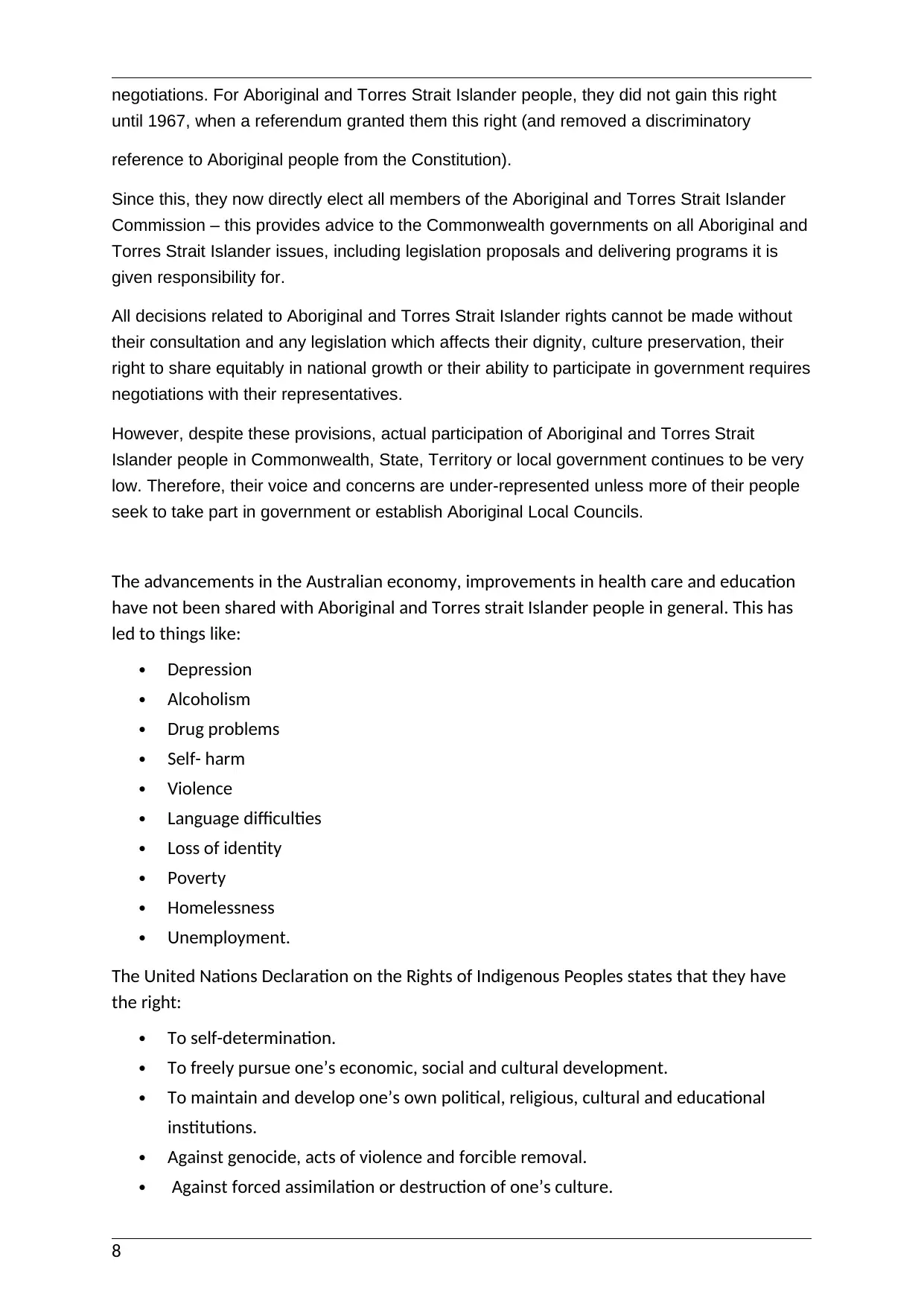
negotiations. For Aboriginal and Torres Strait Islander people, they did not gain this right
until 1967, when a referendum granted them this right (and removed a discriminatory
reference to Aboriginal people from the Constitution).
Since this, they now directly elect all members of the Aboriginal and Torres Strait Islander
Commission – this provides advice to the Commonwealth governments on all Aboriginal and
Torres Strait Islander issues, including legislation proposals and delivering programs it is
given responsibility for.
All decisions related to Aboriginal and Torres Strait Islander rights cannot be made without
their consultation and any legislation which affects their dignity, culture preservation, their
right to share equitably in national growth or their ability to participate in government requires
negotiations with their representatives.
However, despite these provisions, actual participation of Aboriginal and Torres Strait
Islander people in Commonwealth, State, Territory or local government continues to be very
low. Therefore, their voice and concerns are under-represented unless more of their people
seek to take part in government or establish Aboriginal Local Councils.
The advancements in the Australian economy, improvements in health care and education
have not been shared with Aboriginal and Torres strait Islander people in general. This has
led to things like:
Depression
Alcoholism
Drug problems
Self- harm
Violence
Language difficulties
Loss of identity
Poverty
Homelessness
Unemployment.
The United Nations Declaration on the Rights of Indigenous Peoples states that they have
the right:
To self-determination.
To freely pursue one’s economic, social and cultural development.
To maintain and develop one’s own political, religious, cultural and educational
institutions.
Against genocide, acts of violence and forcible removal.
Against forced assimilation or destruction of one’s culture.
8
until 1967, when a referendum granted them this right (and removed a discriminatory
reference to Aboriginal people from the Constitution).
Since this, they now directly elect all members of the Aboriginal and Torres Strait Islander
Commission – this provides advice to the Commonwealth governments on all Aboriginal and
Torres Strait Islander issues, including legislation proposals and delivering programs it is
given responsibility for.
All decisions related to Aboriginal and Torres Strait Islander rights cannot be made without
their consultation and any legislation which affects their dignity, culture preservation, their
right to share equitably in national growth or their ability to participate in government requires
negotiations with their representatives.
However, despite these provisions, actual participation of Aboriginal and Torres Strait
Islander people in Commonwealth, State, Territory or local government continues to be very
low. Therefore, their voice and concerns are under-represented unless more of their people
seek to take part in government or establish Aboriginal Local Councils.
The advancements in the Australian economy, improvements in health care and education
have not been shared with Aboriginal and Torres strait Islander people in general. This has
led to things like:
Depression
Alcoholism
Drug problems
Self- harm
Violence
Language difficulties
Loss of identity
Poverty
Homelessness
Unemployment.
The United Nations Declaration on the Rights of Indigenous Peoples states that they have
the right:
To self-determination.
To freely pursue one’s economic, social and cultural development.
To maintain and develop one’s own political, religious, cultural and educational
institutions.
Against genocide, acts of violence and forcible removal.
Against forced assimilation or destruction of one’s culture.
8
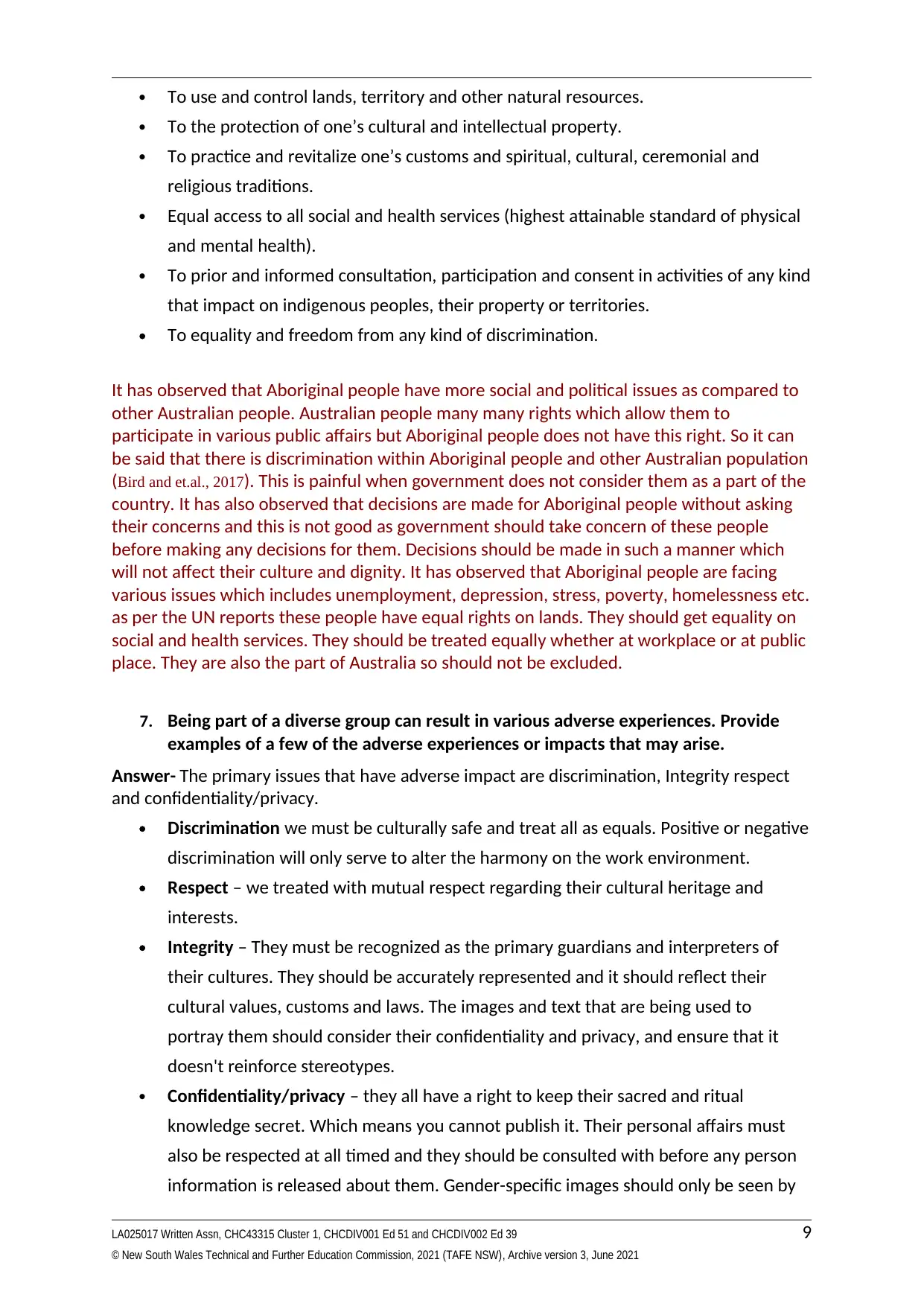
To use and control lands, territory and other natural resources.
To the protection of one’s cultural and intellectual property.
To practice and revitalize one’s customs and spiritual, cultural, ceremonial and
religious traditions.
Equal access to all social and health services (highest attainable standard of physical
and mental health).
To prior and informed consultation, participation and consent in activities of any kind
that impact on indigenous peoples, their property or territories.
To equality and freedom from any kind of discrimination.
It has observed that Aboriginal people have more social and political issues as compared to
other Australian people. Australian people many many rights which allow them to
participate in various public affairs but Aboriginal people does not have this right. So it can
be said that there is discrimination within Aboriginal people and other Australian population
(Bird and et.al., 2017). This is painful when government does not consider them as a part of the
country. It has also observed that decisions are made for Aboriginal people without asking
their concerns and this is not good as government should take concern of these people
before making any decisions for them. Decisions should be made in such a manner which
will not affect their culture and dignity. It has observed that Aboriginal people are facing
various issues which includes unemployment, depression, stress, poverty, homelessness etc.
as per the UN reports these people have equal rights on lands. They should get equality on
social and health services. They should be treated equally whether at workplace or at public
place. They are also the part of Australia so should not be excluded.
7. Being part of a diverse group can result in various adverse experiences. Provide
examples of a few of the adverse experiences or impacts that may arise.
Answer- The primary issues that have adverse impact are discrimination, Integrity respect
and confidentiality/privacy.
Discrimination we must be culturally safe and treat all as equals. Positive or negative
discrimination will only serve to alter the harmony on the work environment.
Respect – we treated with mutual respect regarding their cultural heritage and
interests.
Integrity – They must be recognized as the primary guardians and interpreters of
their cultures. They should be accurately represented and it should reflect their
cultural values, customs and laws. The images and text that are being used to
portray them should consider their confidentiality and privacy, and ensure that it
doesn't reinforce stereotypes.
Confidentiality/privacy – they all have a right to keep their sacred and ritual
knowledge secret. Which means you cannot publish it. Their personal affairs must
also be respected at all timed and they should be consulted with before any person
information is released about them. Gender-specific images should only be seen by
LA025017 Written Assn, CHC43315 Cluster 1, CHCDIV001 Ed 51 and CHCDIV002 Ed 39 9
© New South Wales Technical and Further Education Commission, 2021 (TAFE NSW), Archive version 3, June 2021
To the protection of one’s cultural and intellectual property.
To practice and revitalize one’s customs and spiritual, cultural, ceremonial and
religious traditions.
Equal access to all social and health services (highest attainable standard of physical
and mental health).
To prior and informed consultation, participation and consent in activities of any kind
that impact on indigenous peoples, their property or territories.
To equality and freedom from any kind of discrimination.
It has observed that Aboriginal people have more social and political issues as compared to
other Australian people. Australian people many many rights which allow them to
participate in various public affairs but Aboriginal people does not have this right. So it can
be said that there is discrimination within Aboriginal people and other Australian population
(Bird and et.al., 2017). This is painful when government does not consider them as a part of the
country. It has also observed that decisions are made for Aboriginal people without asking
their concerns and this is not good as government should take concern of these people
before making any decisions for them. Decisions should be made in such a manner which
will not affect their culture and dignity. It has observed that Aboriginal people are facing
various issues which includes unemployment, depression, stress, poverty, homelessness etc.
as per the UN reports these people have equal rights on lands. They should get equality on
social and health services. They should be treated equally whether at workplace or at public
place. They are also the part of Australia so should not be excluded.
7. Being part of a diverse group can result in various adverse experiences. Provide
examples of a few of the adverse experiences or impacts that may arise.
Answer- The primary issues that have adverse impact are discrimination, Integrity respect
and confidentiality/privacy.
Discrimination we must be culturally safe and treat all as equals. Positive or negative
discrimination will only serve to alter the harmony on the work environment.
Respect – we treated with mutual respect regarding their cultural heritage and
interests.
Integrity – They must be recognized as the primary guardians and interpreters of
their cultures. They should be accurately represented and it should reflect their
cultural values, customs and laws. The images and text that are being used to
portray them should consider their confidentiality and privacy, and ensure that it
doesn't reinforce stereotypes.
Confidentiality/privacy – they all have a right to keep their sacred and ritual
knowledge secret. Which means you cannot publish it. Their personal affairs must
also be respected at all timed and they should be consulted with before any person
information is released about them. Gender-specific images should only be seen by
LA025017 Written Assn, CHC43315 Cluster 1, CHCDIV001 Ed 51 and CHCDIV002 Ed 39 9
© New South Wales Technical and Further Education Commission, 2021 (TAFE NSW), Archive version 3, June 2021
⊘ This is a preview!⊘
Do you want full access?
Subscribe today to unlock all pages.

Trusted by 1+ million students worldwide
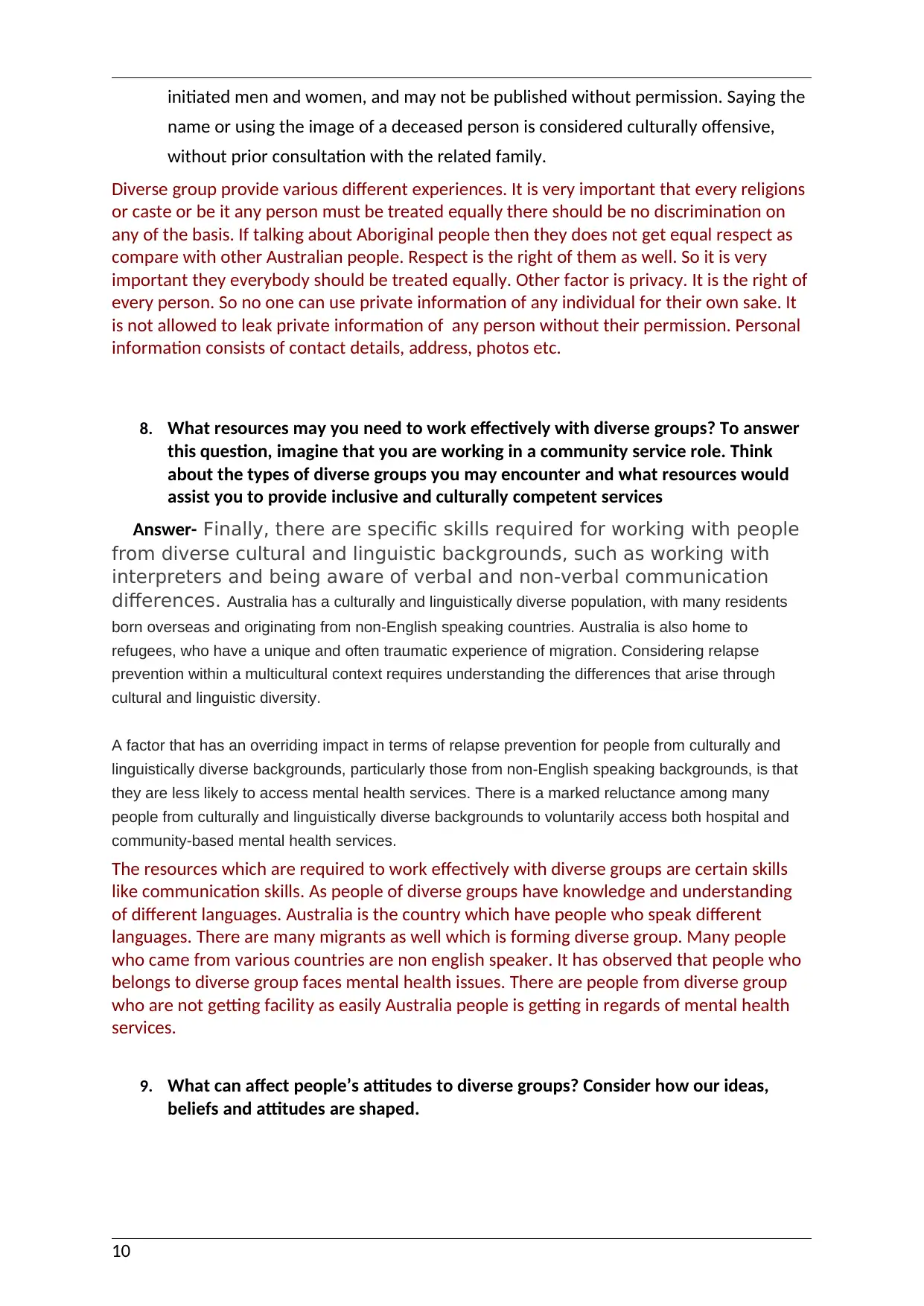
initiated men and women, and may not be published without permission. Saying the
name or using the image of a deceased person is considered culturally offensive,
without prior consultation with the related family.
Diverse group provide various different experiences. It is very important that every religions
or caste or be it any person must be treated equally there should be no discrimination on
any of the basis. If talking about Aboriginal people then they does not get equal respect as
compare with other Australian people. Respect is the right of them as well. So it is very
important they everybody should be treated equally. Other factor is privacy. It is the right of
every person. So no one can use private information of any individual for their own sake. It
is not allowed to leak private information of any person without their permission. Personal
information consists of contact details, address, photos etc.
8. What resources may you need to work effectively with diverse groups? To answer
this question, imagine that you are working in a community service role. Think
about the types of diverse groups you may encounter and what resources would
assist you to provide inclusive and culturally competent services
Answer- Finally, there are specific skills required for working with people
from diverse cultural and linguistic backgrounds, such as working with
interpreters and being aware of verbal and non-verbal communication
differences. Australia has a culturally and linguistically diverse population, with many residents
born overseas and originating from non-English speaking countries. Australia is also home to
refugees, who have a unique and often traumatic experience of migration. Considering relapse
prevention within a multicultural context requires understanding the differences that arise through
cultural and linguistic diversity.
A factor that has an overriding impact in terms of relapse prevention for people from culturally and
linguistically diverse backgrounds, particularly those from non-English speaking backgrounds, is that
they are less likely to access mental health services. There is a marked reluctance among many
people from culturally and linguistically diverse backgrounds to voluntarily access both hospital and
community-based mental health services.
The resources which are required to work effectively with diverse groups are certain skills
like communication skills. As people of diverse groups have knowledge and understanding
of different languages. Australia is the country which have people who speak different
languages. There are many migrants as well which is forming diverse group. Many people
who came from various countries are non english speaker. It has observed that people who
belongs to diverse group faces mental health issues. There are people from diverse group
who are not getting facility as easily Australia people is getting in regards of mental health
services.
9. What can affect people’s attitudes to diverse groups? Consider how our ideas,
beliefs and attitudes are shaped.
10
name or using the image of a deceased person is considered culturally offensive,
without prior consultation with the related family.
Diverse group provide various different experiences. It is very important that every religions
or caste or be it any person must be treated equally there should be no discrimination on
any of the basis. If talking about Aboriginal people then they does not get equal respect as
compare with other Australian people. Respect is the right of them as well. So it is very
important they everybody should be treated equally. Other factor is privacy. It is the right of
every person. So no one can use private information of any individual for their own sake. It
is not allowed to leak private information of any person without their permission. Personal
information consists of contact details, address, photos etc.
8. What resources may you need to work effectively with diverse groups? To answer
this question, imagine that you are working in a community service role. Think
about the types of diverse groups you may encounter and what resources would
assist you to provide inclusive and culturally competent services
Answer- Finally, there are specific skills required for working with people
from diverse cultural and linguistic backgrounds, such as working with
interpreters and being aware of verbal and non-verbal communication
differences. Australia has a culturally and linguistically diverse population, with many residents
born overseas and originating from non-English speaking countries. Australia is also home to
refugees, who have a unique and often traumatic experience of migration. Considering relapse
prevention within a multicultural context requires understanding the differences that arise through
cultural and linguistic diversity.
A factor that has an overriding impact in terms of relapse prevention for people from culturally and
linguistically diverse backgrounds, particularly those from non-English speaking backgrounds, is that
they are less likely to access mental health services. There is a marked reluctance among many
people from culturally and linguistically diverse backgrounds to voluntarily access both hospital and
community-based mental health services.
The resources which are required to work effectively with diverse groups are certain skills
like communication skills. As people of diverse groups have knowledge and understanding
of different languages. Australia is the country which have people who speak different
languages. There are many migrants as well which is forming diverse group. Many people
who came from various countries are non english speaker. It has observed that people who
belongs to diverse group faces mental health issues. There are people from diverse group
who are not getting facility as easily Australia people is getting in regards of mental health
services.
9. What can affect people’s attitudes to diverse groups? Consider how our ideas,
beliefs and attitudes are shaped.
10
Paraphrase This Document
Need a fresh take? Get an instant paraphrase of this document with our AI Paraphraser
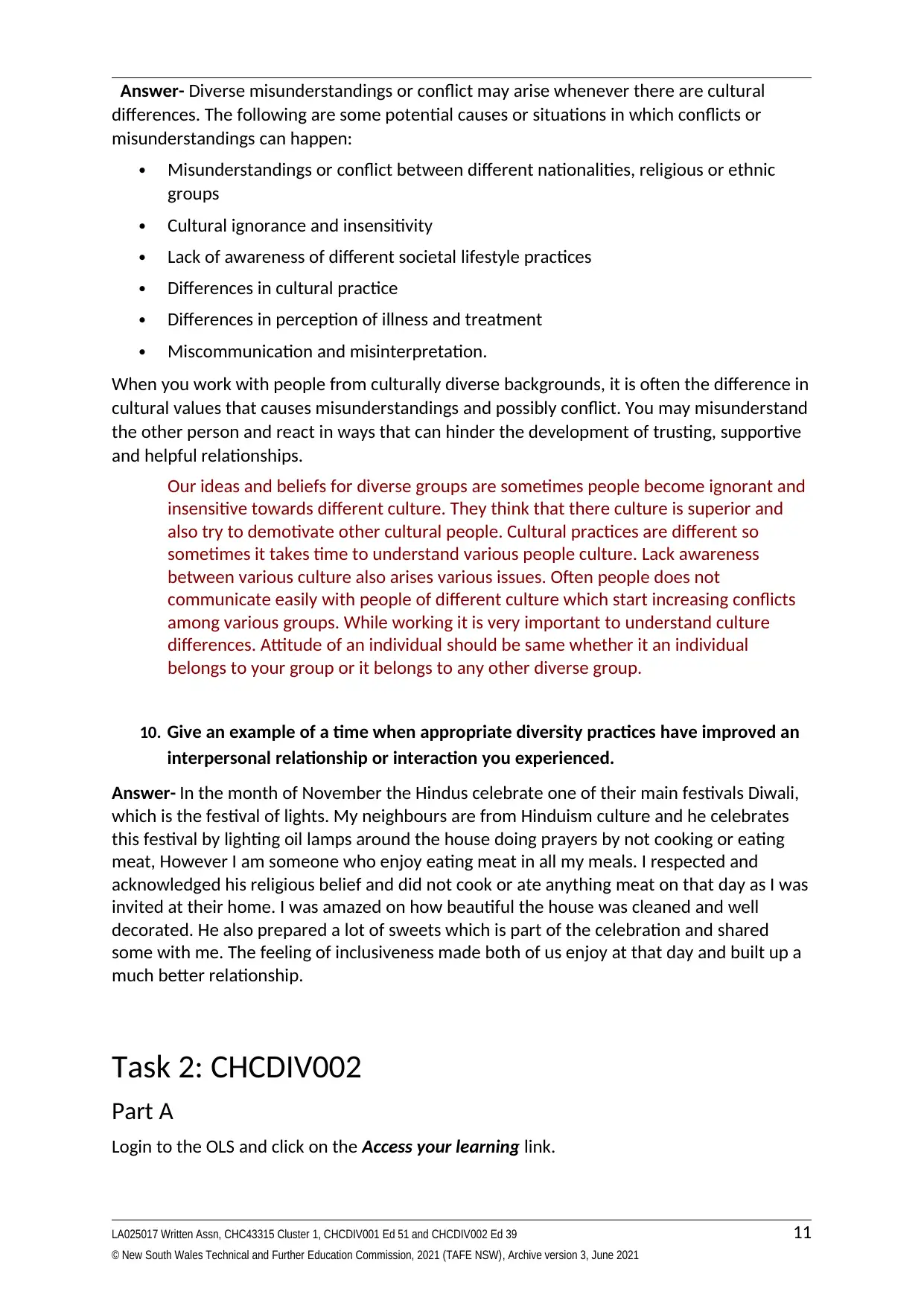
Answer- Diverse misunderstandings or conflict may arise whenever there are cultural
differences. The following are some potential causes or situations in which conflicts or
misunderstandings can happen:
Misunderstandings or conflict between different nationalities, religious or ethnic
groups
Cultural ignorance and insensitivity
Lack of awareness of different societal lifestyle practices
Differences in cultural practice
Differences in perception of illness and treatment
Miscommunication and misinterpretation.
When you work with people from culturally diverse backgrounds, it is often the difference in
cultural values that causes misunderstandings and possibly conflict. You may misunderstand
the other person and react in ways that can hinder the development of trusting, supportive
and helpful relationships.
Our ideas and beliefs for diverse groups are sometimes people become ignorant and
insensitive towards different culture. They think that there culture is superior and
also try to demotivate other cultural people. Cultural practices are different so
sometimes it takes time to understand various people culture. Lack awareness
between various culture also arises various issues. Often people does not
communicate easily with people of different culture which start increasing conflicts
among various groups. While working it is very important to understand culture
differences. Attitude of an individual should be same whether it an individual
belongs to your group or it belongs to any other diverse group.
10. Give an example of a time when appropriate diversity practices have improved an
interpersonal relationship or interaction you experienced.
Answer- In the month of November the Hindus celebrate one of their main festivals Diwali,
which is the festival of lights. My neighbours are from Hinduism culture and he celebrates
this festival by lighting oil lamps around the house doing prayers by not cooking or eating
meat, However I am someone who enjoy eating meat in all my meals. I respected and
acknowledged his religious belief and did not cook or ate anything meat on that day as I was
invited at their home. I was amazed on how beautiful the house was cleaned and well
decorated. He also prepared a lot of sweets which is part of the celebration and shared
some with me. The feeling of inclusiveness made both of us enjoy at that day and built up a
much better relationship.
Task 2: CHCDIV002
Part A
Login to the OLS and click on the Access your learning link.
LA025017 Written Assn, CHC43315 Cluster 1, CHCDIV001 Ed 51 and CHCDIV002 Ed 39 11
© New South Wales Technical and Further Education Commission, 2021 (TAFE NSW), Archive version 3, June 2021
differences. The following are some potential causes or situations in which conflicts or
misunderstandings can happen:
Misunderstandings or conflict between different nationalities, religious or ethnic
groups
Cultural ignorance and insensitivity
Lack of awareness of different societal lifestyle practices
Differences in cultural practice
Differences in perception of illness and treatment
Miscommunication and misinterpretation.
When you work with people from culturally diverse backgrounds, it is often the difference in
cultural values that causes misunderstandings and possibly conflict. You may misunderstand
the other person and react in ways that can hinder the development of trusting, supportive
and helpful relationships.
Our ideas and beliefs for diverse groups are sometimes people become ignorant and
insensitive towards different culture. They think that there culture is superior and
also try to demotivate other cultural people. Cultural practices are different so
sometimes it takes time to understand various people culture. Lack awareness
between various culture also arises various issues. Often people does not
communicate easily with people of different culture which start increasing conflicts
among various groups. While working it is very important to understand culture
differences. Attitude of an individual should be same whether it an individual
belongs to your group or it belongs to any other diverse group.
10. Give an example of a time when appropriate diversity practices have improved an
interpersonal relationship or interaction you experienced.
Answer- In the month of November the Hindus celebrate one of their main festivals Diwali,
which is the festival of lights. My neighbours are from Hinduism culture and he celebrates
this festival by lighting oil lamps around the house doing prayers by not cooking or eating
meat, However I am someone who enjoy eating meat in all my meals. I respected and
acknowledged his religious belief and did not cook or ate anything meat on that day as I was
invited at their home. I was amazed on how beautiful the house was cleaned and well
decorated. He also prepared a lot of sweets which is part of the celebration and shared
some with me. The feeling of inclusiveness made both of us enjoy at that day and built up a
much better relationship.
Task 2: CHCDIV002
Part A
Login to the OLS and click on the Access your learning link.
LA025017 Written Assn, CHC43315 Cluster 1, CHCDIV001 Ed 51 and CHCDIV002 Ed 39 11
© New South Wales Technical and Further Education Commission, 2021 (TAFE NSW), Archive version 3, June 2021
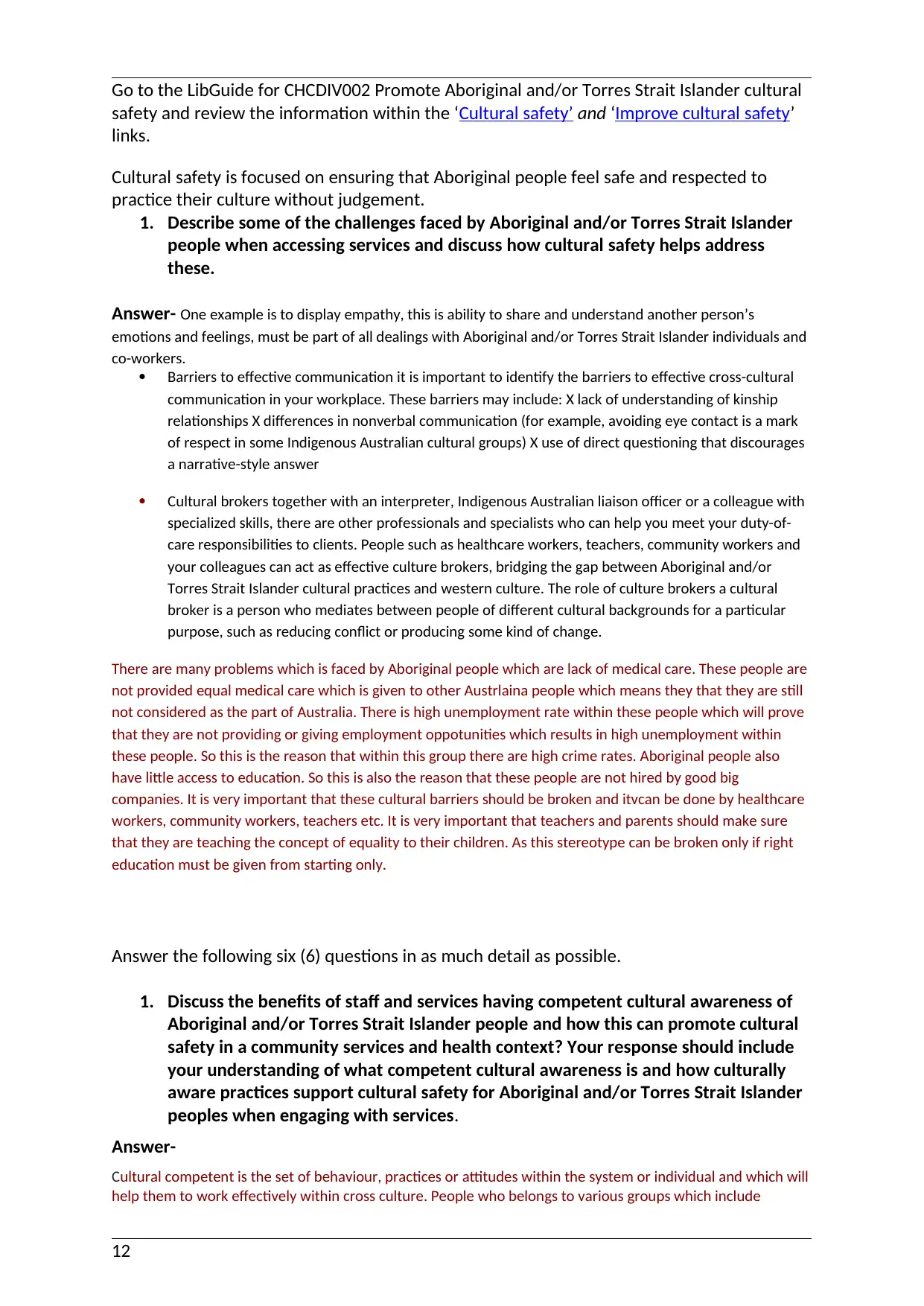
Go to the LibGuide for CHCDIV002 Promote Aboriginal and/or Torres Strait Islander cultural
safety and review the information within the ‘Cultural safety’ and ‘Improve cultural safety’
links.
Cultural safety is focused on ensuring that Aboriginal people feel safe and respected to
practice their culture without judgement.
1. Describe some of the challenges faced by Aboriginal and/or Torres Strait Islander
people when accessing services and discuss how cultural safety helps address
these.
Answer- One example is to display empathy, this is ability to share and understand another person’s
emotions and feelings, must be part of all dealings with Aboriginal and/or Torres Strait Islander individuals and
co-workers.
Barriers to effective communication it is important to identify the barriers to effective cross-cultural
communication in your workplace. These barriers may include: X lack of understanding of kinship
relationships X differences in nonverbal communication (for example, avoiding eye contact is a mark
of respect in some Indigenous Australian cultural groups) X use of direct questioning that discourages
a narrative-style answer
Cultural brokers together with an interpreter, Indigenous Australian liaison officer or a colleague with
specialized skills, there are other professionals and specialists who can help you meet your duty-of-
care responsibilities to clients. People such as healthcare workers, teachers, community workers and
your colleagues can act as effective culture brokers, bridging the gap between Aboriginal and/or
Torres Strait Islander cultural practices and western culture. The role of culture brokers a cultural
broker is a person who mediates between people of different cultural backgrounds for a particular
purpose, such as reducing conflict or producing some kind of change.
There are many problems which is faced by Aboriginal people which are lack of medical care. These people are
not provided equal medical care which is given to other Austrlaina people which means they that they are still
not considered as the part of Australia. There is high unemployment rate within these people which will prove
that they are not providing or giving employment oppotunities which results in high unemployment within
these people. So this is the reason that within this group there are high crime rates. Aboriginal people also
have little access to education. So this is also the reason that these people are not hired by good big
companies. It is very important that these cultural barriers should be broken and itvcan be done by healthcare
workers, community workers, teachers etc. It is very important that teachers and parents should make sure
that they are teaching the concept of equality to their children. As this stereotype can be broken only if right
education must be given from starting only.
Answer the following six (6) questions in as much detail as possible.
1. Discuss the benefits of staff and services having competent cultural awareness of
Aboriginal and/or Torres Strait Islander people and how this can promote cultural
safety in a community services and health context? Your response should include
your understanding of what competent cultural awareness is and how culturally
aware practices support cultural safety for Aboriginal and/or Torres Strait Islander
peoples when engaging with services.
Answer-
Cultural competent is the set of behaviour, practices or attitudes within the system or individual and which will
help them to work effectively within cross culture. People who belongs to various groups which include
12
safety and review the information within the ‘Cultural safety’ and ‘Improve cultural safety’
links.
Cultural safety is focused on ensuring that Aboriginal people feel safe and respected to
practice their culture without judgement.
1. Describe some of the challenges faced by Aboriginal and/or Torres Strait Islander
people when accessing services and discuss how cultural safety helps address
these.
Answer- One example is to display empathy, this is ability to share and understand another person’s
emotions and feelings, must be part of all dealings with Aboriginal and/or Torres Strait Islander individuals and
co-workers.
Barriers to effective communication it is important to identify the barriers to effective cross-cultural
communication in your workplace. These barriers may include: X lack of understanding of kinship
relationships X differences in nonverbal communication (for example, avoiding eye contact is a mark
of respect in some Indigenous Australian cultural groups) X use of direct questioning that discourages
a narrative-style answer
Cultural brokers together with an interpreter, Indigenous Australian liaison officer or a colleague with
specialized skills, there are other professionals and specialists who can help you meet your duty-of-
care responsibilities to clients. People such as healthcare workers, teachers, community workers and
your colleagues can act as effective culture brokers, bridging the gap between Aboriginal and/or
Torres Strait Islander cultural practices and western culture. The role of culture brokers a cultural
broker is a person who mediates between people of different cultural backgrounds for a particular
purpose, such as reducing conflict or producing some kind of change.
There are many problems which is faced by Aboriginal people which are lack of medical care. These people are
not provided equal medical care which is given to other Austrlaina people which means they that they are still
not considered as the part of Australia. There is high unemployment rate within these people which will prove
that they are not providing or giving employment oppotunities which results in high unemployment within
these people. So this is the reason that within this group there are high crime rates. Aboriginal people also
have little access to education. So this is also the reason that these people are not hired by good big
companies. It is very important that these cultural barriers should be broken and itvcan be done by healthcare
workers, community workers, teachers etc. It is very important that teachers and parents should make sure
that they are teaching the concept of equality to their children. As this stereotype can be broken only if right
education must be given from starting only.
Answer the following six (6) questions in as much detail as possible.
1. Discuss the benefits of staff and services having competent cultural awareness of
Aboriginal and/or Torres Strait Islander people and how this can promote cultural
safety in a community services and health context? Your response should include
your understanding of what competent cultural awareness is and how culturally
aware practices support cultural safety for Aboriginal and/or Torres Strait Islander
peoples when engaging with services.
Answer-
Cultural competent is the set of behaviour, practices or attitudes within the system or individual and which will
help them to work effectively within cross culture. People who belongs to various groups which include
12
⊘ This is a preview!⊘
Do you want full access?
Subscribe today to unlock all pages.

Trusted by 1+ million students worldwide
1 out of 18
Related Documents
Your All-in-One AI-Powered Toolkit for Academic Success.
+13062052269
info@desklib.com
Available 24*7 on WhatsApp / Email
![[object Object]](/_next/static/media/star-bottom.7253800d.svg)
Unlock your academic potential
Copyright © 2020–2025 A2Z Services. All Rights Reserved. Developed and managed by ZUCOL.





